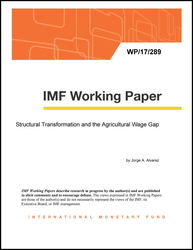
Structural Transformation and the Agricultural Wage Gap
Structural Transformation and the Agricultural Wage Gap
READ MORE...
Volume/Issue:
Volume 2017
Issue 289
Publication date: December 2017
ISBN: 9781484335444
$20.00
Add to Cart by clicking price of the language and format you'd like to purchase
Available Languages and Formats
| English |
Prices in red indicate formats that are not yet available but are forthcoming.
Topics covered in this book
This title contains information about the following subjects.
Click on a subject if you would like to see other titles with the same subjects.
Labor , Economics- Macroeconomics , Industries - Manufacturing , Agribusiness , WP , appendix E , gap decline , Wage Gaps , Structural Transformation , Agriculture , Human Capital , Sorting , Productivity Gaps , Brazil , wage gap , gap level , wage difference , skilled worker , differential pay , wage gain , Agricultural sector , Wage gap , Wages , Manufacturing
Summary
A key feature of developing economies is that wages in agriculture are significantly below those of other sectors. Using Brazilian household surveys and administrative panel data, I use information on workers who switch sectors to decompose the drivers of this gap. I find that most of the gap is explained by differences in worker composition. The evidence speaks against the existence of large short-term gains from reallocating workers out of agriculture and favors recently proposed Roy models of inter-sector sorting. A calibrated sorting model of structural transformation can account for the wage gap level observed and its decline as the economy transitioned out of agriculture.
Copyright © 2010 - 2024
Powered by:
AIDC



